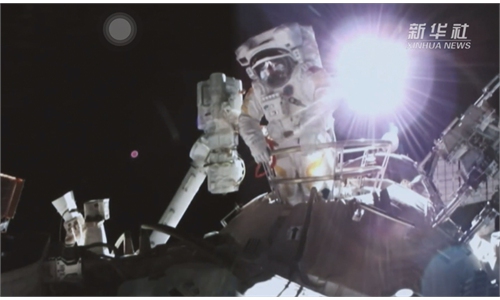SCI-TECH / AIR & SPACE
Update: Shenzhou-13 crew delivers 2nd spacewalk
Video: GT
Shenzhou-13 spaceflight mission commander Zhai Zhigang and the youngest member of the crew, Ye Guangfu, safely returned to China’s Tianhe space station core module at 0:55 am Monday, Beijing time, after a smooth spacewalk that lasted for about six hours, according to an official release by the China Manned Space Agency (CMSA).
The crew completed all set goals for the spacewalk mission, including elevating the panoramic camera C and installing foot fixers outside the cabin.
Shenzhou-13 taikonauts Zhai Zhigang and Ye Guangfu conducted a spacewalk from China's orbiting Tianhe space station core module, the crew's second extravehicular activity (EVA,) starting at 6.44 pm on Sunday, the same day as the 128th birth anniversary of late Chinese leader Mao Zedong.
According to the China Manned Space Agency, Ye opened the airlock door around 6:44 pm and was the first to exit the module, with Zhai following him.
Chinese observers said that while a spacewalk is always planned far in advance due to technological reasons, they are confident enough that such a high-stakes mission on a date of special significance shows that China's manned space technology has greatly matured and is developing into a new normal amid busy space station construction.
This is China's fourth spacewalk from the Tianhe space station core module this year. And it took place when the Shenzhou-13 crew have been working and living in the Tianhe craft for 72 days and less than two months after their first spacewalk on November 7, when Wang Yaping became the country's first female astronaut to conduct a spacewalk.
Wang this time played a support role inside the cabin, while her fellow taikonauts Zhai and Ye put on the domestically developed Feitian spacesuits to perform the spacewalk. It was Ye's first spacewalk.
Song Zhongping, a space industry analyst and TV commentator, told the Global Times on Sunday that rotating the crew on spacewalks would help train more taikonauts and equip them with the capability as well as provide valuable experience.
Mission insiders revealed to the Global Times on Sunday that one of the major tasks for Zhai and Ye's spacewalk is to elevate the panoramic camera C outside the cabin with the assistance of the robotic arm.
Hu Chengwei, who is in charge of the robotic arm technology development with the China Academy of Spacecraft Technology (CAST), said it demands high safety and precision to keep the robotic arm's movement steady and accurate so it would not clash with the outside-cabin equipment while reaching the camera.
The robotic arm development team worked with the space station system to carry out multiple simulations to enable the smooth execution of the job, Hu told the Global Times on Sunday.
The robotic arm is also expected to help the taikonauts reach the target workplace by installing a foothold which will also allow taikonauts to free their hands to do more complicated work outside the cabin in the future, according to CAST.
The Shenzhou-13 crew is expected to stay for a record-breaking six months in orbit for a Chinese mission, during which two to three spacewalk missions are planned, mission insiders previously said.
This year's anniversary of Mao's birth has already seen more space-related activities than before.
On Saturday, the China National Space Administration handed over the previous lunar samples that are part of China's Chang'e-5 harvest in 2020 to the newly built backup storage station in Shaoshan - the birthplace of the late Chinese leader.
Zhang Kejian, the CNSA chief, stressed on Saturday at the handover ceremony that storing lunar samples at Shaoshan represents the deep respect and thoughts toward the late Chinese leader and his great achievement to the Chinese people and the whole world and it also answers to Chairman Mao's great vision of "We can bring down the moon from the Ninth Heaven" by fully demonstrating the innovation and progress of China's space program.
Also on Sunday morning, China launched a new land resource satellite codenamed Ziyuan-1 02E and a mini satellite for science popularization to a preset orbit via a Long March-4C carrier rocket from Taiyuan Satellite Launch Center in North China's Shanxi Province.


